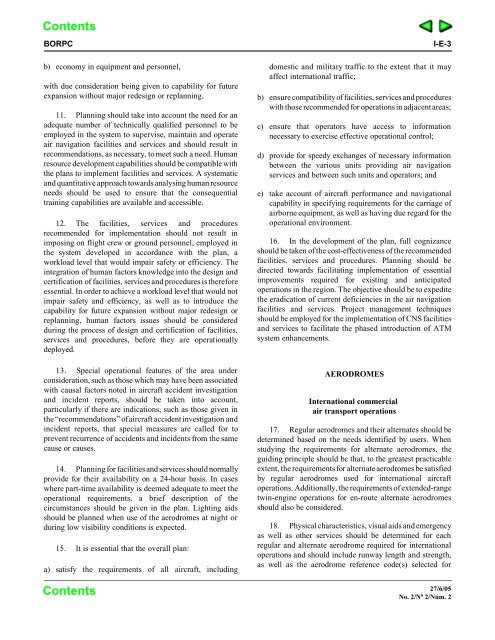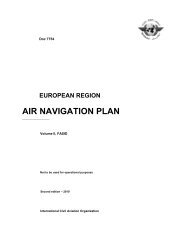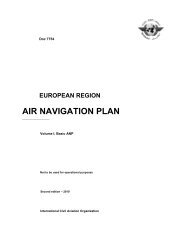introduction - ICAO Public Maps
introduction - ICAO Public Maps
introduction - ICAO Public Maps
Create successful ePaper yourself
Turn your PDF publications into a flip-book with our unique Google optimized e-Paper software.
BORPC<br />
b) economy in equipment and personnel,<br />
with due consideration being given to capability for future<br />
expansion without major redesign or replanning.<br />
11. Planning should take into account the need for an<br />
adequate number of technically qualified personnel to be<br />
employed in the system to supervise, maintain and operate<br />
air navigation facilities and services and should result in<br />
recommendations, as necessary, to meet such a need. Human<br />
resource development capabilities should be compatible with<br />
the plans to implement facilities and services. A systematic<br />
and quantitative approach towards analysing human resource<br />
needs should be used to ensure that the consequential<br />
training capabilities are available and accessible.<br />
12. The facilities, services and procedures<br />
recommended for implementation should not result in<br />
imposing on flight crew or ground personnel, employed in<br />
the system developed in accordance with the plan, a<br />
workload level that would impair safety or efficiency. The<br />
integration of human factors knowledge into the design and<br />
certification of facilities, services and procedures is therefore<br />
essential. In order to achieve a workload level that would not<br />
impair safety and efficiency, as well as to introduce the<br />
capability for future expansion without major redesign or<br />
replanning, human factors issues should be considered<br />
during the process of design and certification of facilities,<br />
services and procedures, before they are operationally<br />
deployed.<br />
13. Special operational features of the area under<br />
consideration, such as those which may have been associated<br />
with causal factors noted in aircraft accident investigation<br />
and incident reports, should be taken into account,<br />
particularly if there are indications, such as those given in<br />
the “recommendations” of aircraft accident investigation and<br />
incident reports, that special measures are called for to<br />
prevent recurrence of accidents and incidents from the same<br />
cause or causes.<br />
14. Planning for facilities and services should normally<br />
provide for their availability on a 24-hour basis. In cases<br />
where part-time availability is deemed adequate to meet the<br />
operational requirements, a brief description of the<br />
circumstances should be given in the plan. Lighting aids<br />
should be planned when use of the aerodromes at night or<br />
during low visibility conditions is expected.<br />
15. It is essential that the overall plan:<br />
a) satisfy the requirements of all aircraft, including<br />
I-E-3<br />
domestic and military traffic to the extent that it may<br />
affect international traffic;<br />
b) ensure compatibility of facilities, services and procedures<br />
with those recommended for operations in adjacent areas;<br />
c) ensure that operators have access to information<br />
necessary to exercise effective operational control;<br />
d) provide for speedy exchanges of necessary information<br />
between the various units providing air navigation<br />
services and between such units and operators; and<br />
e) take account of aircraft performance and navigational<br />
capability in specifying requirements for the carriage of<br />
airborne equipment, as well as having due regard for the<br />
operational environment.<br />
16. In the development of the plan, full cognizance<br />
should be taken of the cost-effectiveness of the recommended<br />
facilities, services and procedures. Planning should be<br />
directed towards facilitating implementation of essential<br />
improvements required for existing and anticipated<br />
operations in the region. The objective should be to expedite<br />
the eradication of current deficiencies in the air navigation<br />
facilities and services. Project management techniques<br />
should be employed for the implementation of CNS facilities<br />
and services to facilitate the phased <strong>introduction</strong> of ATM<br />
system enhancements.<br />
AERODROMES<br />
International commercial<br />
air transport operations<br />
17. Regular aerodromes and their alternates should be<br />
determined based on the needs identified by users. When<br />
studying the requirements for alternate aerodromes, the<br />
guiding principle should be that, to the greatest practicable<br />
extent, the requirements for alternate aerodromes be satisfied<br />
by regular aerodromes used for international aircraft<br />
operations. Additionally, the requirements of extended-range<br />
twin-engine operations for en-route alternate aerodromes<br />
should also be considered.<br />
18. Physical characteristics, visual aids and emergency<br />
as well as other services should be determined for each<br />
regular and alternate aerodrome required for international<br />
operations and should include runway length and strength,<br />
as well as the aerodrome reference code(s) selected for<br />
27/6/05<br />
No. 2/Nº 2/Núm. 2














